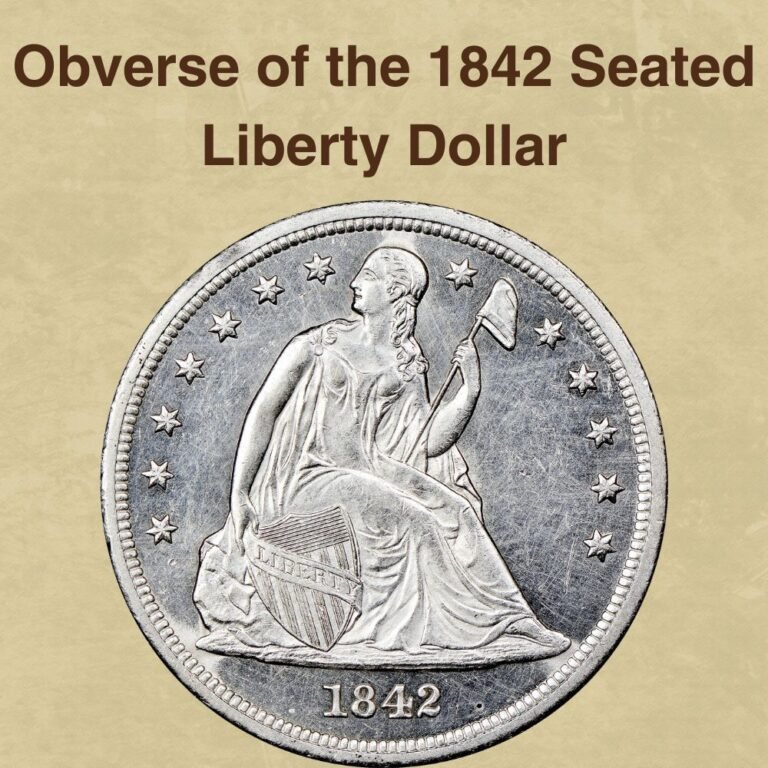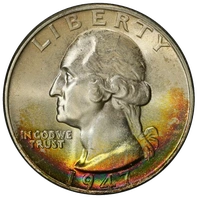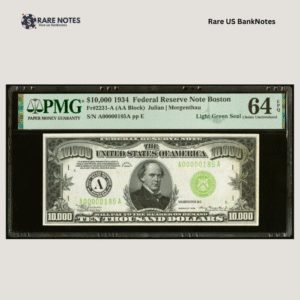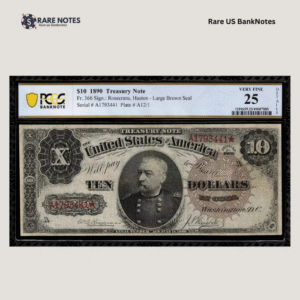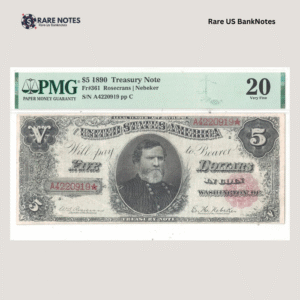Are you building your Draped Bust coin collection? If so, you’re probably curious about the 1796 dime value and whether this coin is worth collecting. If you already own this old coin, you might also be eager to find out how much it is worth. Whether you are a new or seasoned collector, this guide will explain everything you need to know about the 1796 Draped Bust dime.
The 1796 dime holds historical and sentimental significance. This is not just any old coin, rather it was the first silver dime struck by the United States Mint. This date is considered rare given its acutely low mintage, making it a collectors’ favorite. Adding it to your collection can significantly improve its value.
In this article, we’ll walk you through the history of the 1796 dime and learn about its key physical features. You will also learn tips for grading your coin like a pro and discover fascinating die varieties that make this Draped Bust dime special.
So, let’s dive in and find out: How much is the 1796 dime.
1796 Half Dollar Value Chart |
||||
| Mint Mark | Good | Fine | Extremely Fine | Uncirculated |
| 1796-No Mint Mark Dime Value | $3,300 | $5,900 | $9,000 | $1,115,000 |
History of the 1796 Dime
The 1796 dime was the first dime the United States Mint produced as part of the Draped Bust series, minted between 1796-1907.
The Draped Bust design replaced the Flowing Hair design, which had received intense criticism from officials and the public. In 1796, Congress responded to this criticism by approving a new design.
Robert Scot, the U.S. Mint Chief Engraver, designed the Draped Bust by transforming a portrait of Philadelphia socialite Ann Willing Bingham into a busty Lady Liberty. This obverse design remained the same for several years.
Scot also designed the reverse, producing three different types of designs. The first type was designed for copper coins, including the half cent or one cent and featured the coin’s denomination encircled in a wreath.
Between 1795 and 1797, the reverse of silver coins, including the dime, featured a small bald eagle—this is known as the Draped Bust, Small Eagle and is among the most popular early coin designs due to its low mintage and premium prices.
The design changed again in 1798 when the Heraldic eagle replaced the small eagle, resulting in the equally popular Draped Bust, Heraldic Eagle design.
The 1796 dime is extremely popular due to its low mintage and also the fact that it was the first dime minted in the Draped Bust series. What also stands out is the die varieties in this date, many of which are scarce and highly sought-after by collectors. This historic dime will certainly add immense value to any collection.
Also read: Top 17 Most Valuable Roosevelt Dimes Worth Money
Features of the 1796 Dime
When collecting early coins such as the 1796 dime, it is important to pay attention to the physical attributes. Familiarizing yourself with these features will help with grading and authenticating your coin, and identifying high-value Draped Bust dimes worth adding to your collection.
Obverse of the 1796 Dime

The front side shows Liberty’s right-facing profile in which her hair is flowing lightly and she is draped in clothing that highlights her bust.
The word LIBERTY appears above her and the date 1796 is shown below. Liberty’s portrait is flanked by eight stars to the left and seven to the right.
Reverse of the 1796 Dime

The reverse displays a naturalistic scrawny bald eagle and perched on a billow of clouds with wings spread out.
The eagle’s image is encircled in a wreath consisting of wheat and corn leaves tied at the bottom with a ribbon.
The words UNITED STATES OF AMERICA are etched around the coin’s rim.
Other Features of the 1796 Dime
Additional features of the 1796 dime include:
- Diameter: 19.80 millimeters
- Weight: 2.70 grams
- Edge: Reeded
- Metal Composition: 89.2% Silver, 10.8% Copper
- ASW: 0.0774oz
- Fineness: 0.892
Also read: Top 17 Most Valuable Mercury Dimes Worth Money
1796 Dime Value Guide

Let’s answer the big question: how much is a 1796 dime worth? The value of this historic coin will depend on its condition.
There’s only one variety of the 1796 dime based on mintmark i.e., the 1796 no-mintmark dime. The Philadelphia Mint, the only mint at the time, struck 22,135 silver dimes in 1796. Such low mintages were common in the series at the time but with such a small coin population, you can expect these coins to be extremely rare today.
So, how much can you expect from a 1796 dime. Let’s take a look at the estimated values across different grades.
Circulated Examples: These are relatively scarce, which can be attributed to the coin’s low mintage and age. Survivors are widely circulated and show heavy wear on the obverse and reverse. Most are graded lower than Fine (F) and any pieces designated as Extremely Fine (XF) or About Uncirculated (AU58) are extremely scarce and in high demand. Even in lower grades, circulated pieces will sell for a premium. For example, a piece graded Poor/Average will fetch up to $1950, one graded Good (G) will sell for as much as $3,300, and a Fine (F) one for up to $5,900. Higher up the grade, an Extremely Fine (XF) example will sell for $9000 while an About Uncirculated (AU58) will command prices as high as $21,000.
Mint State Examples: Uncirculated 1796 dimes are rare with most examples attaining grade MS62-MS64. Gems, on the other hand, are extremely rare and any survivor will fetch a fortune. Examples graded MS60 will sell for at least $26,000, one graded MS62 will fetch up to $28,000, while an MS64 will command at least $64,500. Rare gems graded MS65 will command up to $110,000 while an MS68 will bring in at least $1,150,000.
Auction Record: In a record-shattering sale in 2023, Heritage Auctions sold an MS66+ for a whopping $372, 000.
Also read: 13 Most Valuable Dime Errors Worth Money
1796 Dime Grading
Grading 1796 dimes can be a bit challenging, especially for new collectors, because most survivors are heavily worn. The process entails paying close attention to the coin’s design details, luster, and wear.
In particular, you should examine key contact points prone to wear including Liberty’s curls on the obverse and the eagle’s breast and feathers, as well as the laurel on the reverse.
Lower grade dimes will show extensive to moderate wear in these areas. Specifically, Liberty’s outline will be almost non-existent while the stars and inscriptions will show heavy weakness. You will also notice extensive smoothening on the reverse, with most of the eagle’s details being extremely weak and lacking a visible outline.
Mid-grade examples will display moderate wear. Liberty’s details including her hair, as well as the stars and inscriptions are visible, and the outline more pronounced. Liberty’s hair strands are more defined and her cheeks show only moderate wear. Although not sharp, the eagle’s details also have some definition and show less severe wear.
Uncirculated or Mint State examples are rare in this date but are the most desirable. These dimes will show sharp details on the obverse and reverse, and boast original mint luster. No major flaws are visible, except for a few contact marks, mostly seen in lower grade uncirculated pieces.
There are a few more things to keep in mind when grading a 1796 dime. For one, many of these coins display a weak strike but a weak strike doesn’t necessarily mean that the coin is heavily worn. Also, your grading should consider prolonged exposure and environmental damage, which can lower the value of these old coins.
Finally, you can improve your grading accuracy by comparing your coin to high-resolution images from the Professional Coin Grading Service (PCGS) or the Numismatic Guaranty Company (NGC).
Rare 1796 Dime Errors List
When striking the 1796 dimes, the Mint used six obverse dies and paired these with five reverse dies, resulting in six major die varieties. Researcher and numismatic John Reich identified the differences that emerged from these die pairings and came up with JR-1 to JR6 system for grading the varieties.
These varieties are a key component of any 1796 dime collection, with collectors taking pride in identifying one or more of these rare varieties. The die varieties differ in their date placement, position of the stars, and the reverse design.
In addition to some notable minting errors, let’s also look at the major die varieties and how to identify if yours is rare.
1. 1796 Dime JR-1 Variety
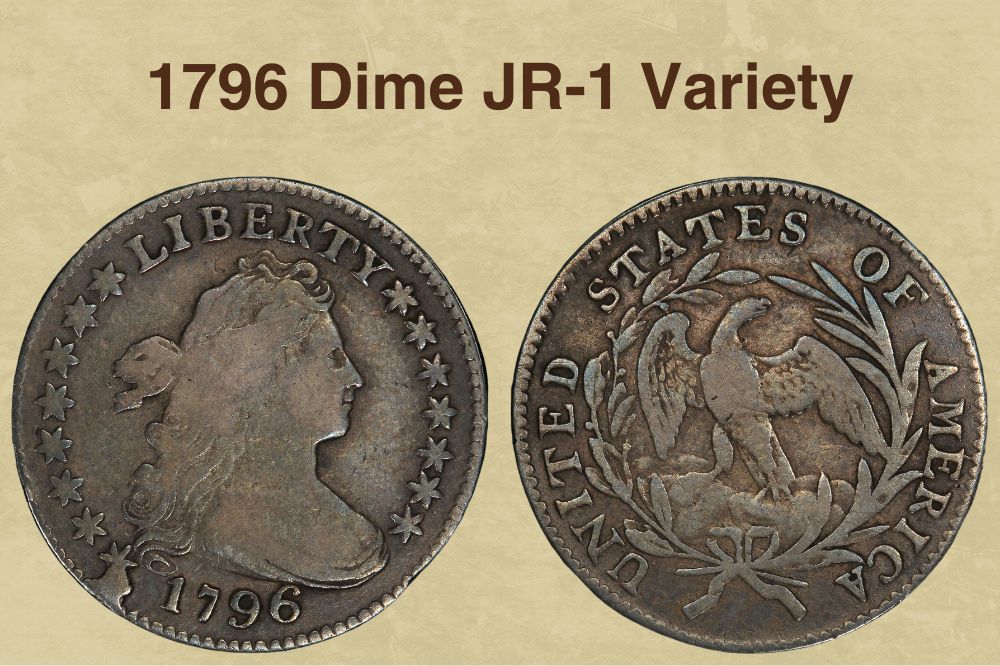
This is also known as the wide-date variety, as there is a significant space between the numbers 7 and 9 in “1796.” On the reverse, the eagle has a closed beak and the tail feather is almost touching the ribbon that binds the wreath. The JR-1 variety is common on many of the surviving examples.
2. 1796 Dime JR-2 Variety

On this second variety, the reverse design is more or less the same as JR-1 but a closer look will reveal slight differences in the position of the eagle’s tail. But, unlike JR-1, the digits in the date are rightly packed together. This variety is relatively scarce but still accessible.
3. 1796 Dime JR-3 Variety

The JR-3 variety is rare and highly sought-after, specifically due to the re-punched date error. When you look at the date closely, you will notice that the 6 in “1796” is re-punched where a larger 6 overlaps with a smaller 6 underneath. Compared to the two previous varieties, the eagle’s tail feather is positioned further away from the ribbon.
4. 1796 Dime JR-4 Variety

Next is the JR-4 variety, which features a notable misaligned star and an oddly placed date on the obverse. In particular, the date is slightly but noticeably tilted and the 8th star is positioned closer to Lady Liberty’s head than in other varieties. On the reverse, die cracks appear on the eagle’s wings. The JR-4 variety is extremely scarce.
5. 1796 Dime JR-5 Variety
The JR-5 variety is notable for its low 6 position in the “1796” date, causing the date to appear misaligned. The reverse also shows some misalignment in which the eagle appears slightly out of balance in relation to the wreath. In later die states, some of the denticle show significant weakness. This variety is rare but can still be collected with some persistence.
6. 1796 Dime JR-6 Variety

The JR-6 is extremely rare and can be difficult, even for seasoned collectors, to find. What sets this variety apart is the perfectly positioned date in which there’s equal spacing between all the numbers.
On the reverse, the laurel wreath is also almost perfect with the leaves showing sharper details than in the preceding varieties.
Just like grading a 1796 dime, when identifying dime varieties, it’s best to compare your coin with certified examples (or images) from reputable entities such as the Heritage Auctions, Numismatic Guaranty Company, and the Professional Coin Grading Service.
Where to Sell Your 1796 Barber Dime?
Now that you know the value of your coins, do you know where to sell those coins online easily? Don’t worry, I’ve compiled a list of these sites, including their introduction, pros, and cons.
Check out now: Best Places To Sell Coins Online (Pros & Cons)
FAQs
How much is a 1796 dime worth today?
The value of a 1796 dime will depend on the coin’s condition. That said, even in lower grades, this historic coin can fetch a premium. Expect between $1,950 and $28,000 for circulated pieces, and up to 1,115,000 or more for Mint State examples and the extremely rare Gems.
Are there any 1796 dimes existing today?
Yes, there are a few survivors of the 1796 dimes. However, majority of these old coins are heavily worn in circulated condition. Mint State examples and Gems are the most desirable for collectors and while you can still find some survivors, they are extremely rare and difficult to come by.
How can I tell if my 1796 dime is real?
Start by finding images of authenticated 1796 dimes to compare the design elements. Check that the obverse and reverse features are intact, even if not entirely visible, in the case of a circulated dime. Ensure that the coin’s dimensions including the weight and diameter are accurate, and that the edge is professionally reeded. Pay attention to the surface for signs of seams, bubbles, and unevenness, which can be signs of a fake 1796 dime. Lastly, you can also perform a magnet test—your silver dime should not be attracted to a magnet.
The post 1796 Dime Coin Value: How Much Is It Worth Today? appeared first on CoinValueChecker.com.




